
A lot of people rightly praise Sam Raimi’s Evil Dead trilogy, but I’ve always preferred his…”more mature” feels like an obscenely inaccurate phrase, so I’ll just call them his “middle-period” pieces. Between Evil Dead 2 and Spider-Man, Raimi struggled for mainstream success, feeling – like every decent genre director in the ’80s and ’90s – that niche audiences and cult success are all well and good…until you looked at the numbers. Besides, Universal wanted to create its own TV channel. Who better to make that happen than a writer/director/producer triple threat?
These struggles cost him fans and failed to win him the wide audience Hollywood’s power brokers and spreadsheet psychics insist every director must possess before they’re allowed to sit in the Front Room with the Grown Ups, where they might accidentally/on-purpose break the studio’s Nice Things (like, oh, I don’t know, say…a profitable superhero franchise). While Darkman and Army of Darkness are “kinder” and “gentler” films than either previous Dead movie (and easier to follow than the Great Black Mark on Raimi’s pre-Spider-Man career, Crimewave), I’m going to own up another Fanboy Heresy and admit I actually prefer them to the original Dead duology.
Not that I don’t love the Dead movies, but I prefer flicks with characters over flicks with mobile viscera containers (that just so happen to speak and/or emote). Why do you think I go out of my way to avoid “art house” or “Sundance Channel” films?
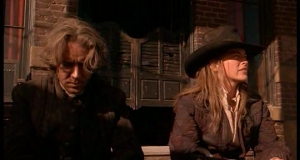
In the universe of all Raimi films, the Dead are clearly young man’s pictures. They remind me of Ben Franklin’s description of the American character (in contrast to the English) in 1776: rougher, simpler films. More violent, more enterprising. And that enterprising nature earned Raimi more fans in less time than most directors gain with an entire body of work. Anyone can make a shitty, “young people in the woods” horror movie or a mid-budget, cash-in-on-Batman…but if you want a Dead By Dawn or a Darkman you need a special kind of lunati.
As a lunatic myself, raised on crappy horror movies, even crappier Westerns, and the same Three Stooges shorts Raimi and his brothers grew up on, I love The Quick and the Dead. From its dusty, jangling spurs to its shot-through-the-brim hat, I love every Sergio Leone-aping minute of it. The fact that more people don’t leaves me fucking flabbergasted.
For one thing, it has best cast of any Western this side of the Cohen brothers. Most people don’t seem to bother reading credits – too much like reading subtitles, which is too much like reading books – but for we fans of the passing-strange, this reads like the All-Star line-up of [insert your favorite sports team during their championship year here]. This is how people in 1962 felt, reading the credits for The Longest Day. Past the famous leads, we’ve got Keith David, Lance Henriksen, Pat Hingle, Roberts Blossom (or “Goliath, Frank Black, Commissioner Gordon and Wild Bob Cody,” as I knew them back when I first saw this) and…Tobin Bell? Holy shit, you guys: Jigsaw‘s in this movie.
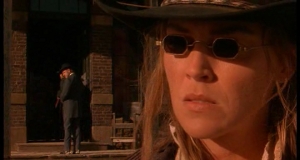
In fact, he’s the first character we meet. Fearing a lone rider’s come to hijack his treasure hunt, he almost shoots our protagonist in the head. After pistol whipping him for lending his name and star power to a repetitive series of over-hyped, bullshit “horror” movies, we see a shot of our protagonist standing over Bell’s prone form, sunlight streaming through the new hole in her exceptionally-awesome hat. Calling him an “asshole,” she chains Jigsaw to a wagon wheel and decides to play a little game. It’s called, You die of dehydration and vultures eat your eyeballs.
Just kidding. Sure, Our Heroine leaves Tobin Bell out in the middle of nowhere, but it’s not like she really cares about him, or his appreciation for life. She’s got battered fish to fry in the nearby town of…Redemption. As the Symbolism Alerts rang in my head, we see Our Heroine have a Traumatic Flashback over the burned out wreckage of the Sheriff’s office. If you can’t guess the rest of this plot from that flashback alone, you really do need to watch more Spaghetti Westerns.
Sometimes it’s hard to tell when filmmakers expect me to take them seriously; whether they’re purposefully being this heavy-handed with their symbolism, or whether they’ve reduced it down to please a studio distributor. With Raimi, that’s (almost) never the case. I know he knows that I know how smack-you-in-the-face obvious naming your Western town “Redemption” really is…because he has Our Heroine walk her (black) horse right past the letters of that word, written in dried-blood red on individual posts of a fence. Meaning Our Heroine’s literally on the Road to Redemption…c’mon guys. It’s a joke. Laugh!
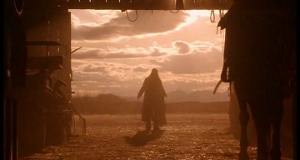
Throughout my life, I’ve had to put up with moans and groans from purists raised on the films Wayne, Ford, and Eastwood. The Western is dead, they said. There’s nothing new under the sun. We’ve seen it all before and it walls all done better when we were kids, damnit. These same people turned their noses up at The Quick and the Dead because it dares to say, Nothing new? You’re absolutely right. It’s all about how you use what you have. But I’ll show you “better.” You know that shot in every Western, where the The Hero walks into The Saloon? Well, here’s Catherine Tremell. And for a brief, shining moment between 1992 and 1998, adding Sharon Stone to anything automatically made it better.
That’s mostly because the film expects us to view her as someone capable of murder – because every one else in the film is…apart form Pat Hingle. He plays the Bartender who mistakes Stone’s Lady for a whore and ends up eating floor for his trouble. By casting a woman as the Man With No Name who rides into town to Right Wrongs with a Six Gun, The Quick and the Dead internalizes the misogynistic conflicts inherent in Western genre – a place where women usually exist to be tied to train tracks and/or raped. Unless it’s a musical comedy. In which case, women exist to sing songs about how much Chicago sucks.
Yeah, you tell ’em, Jane.
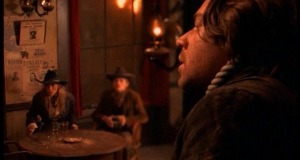
It’s similar to how Clint Eastwood’s Man With No Name internalized the Western’s dichotomy between savagery and civilization. In order to hack civilization out of the Wilderness, you need a savage man with a gun. But because he’s so savage, he has to ride off into the sunset, leaving more civilized people to rule over the order he’s helped create. Should the Western Hero stick around, more often then not he’ll become a corrupt, evil bastard, reducing civilization to his own private fiefdom. Forcing yet another Man (or Woman) With No Name to come along and start the whole sad cycle over again…
Raimi knows this because he knows exactly what people expect from their Westerns. But he also knows why people who don’t like Westerns don’t like them. He goes out of his way to check all the boxes he needs before cutting straight to “the good part.” Stock, one-note characters you can identify by nouns? Check. Transparent set-up for a film full of gunfights? Oh, yeah. Baby Leonardo DiCaprio? Sure, why not? And how about pre-Oscar Russell Crowe as our Preacher With a Dark Secret?
Calling this movie formulaic and simple is like calling Dracula a vampire. It’s characters are as transparent as invisible supervillains. That’s why Raimi brackets this shot of the film’s Boastful Gunfighter, Ace Hanlin (Henriksen) framed by the hollow card he’s just shot through after flipping off the back of a horse
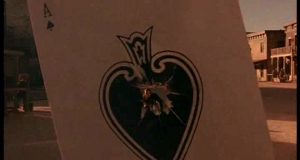
with this shot of Redemption’s mayor and the film’s actual gunfighter, Mr. Herod (Gene Hackman) framed by the hole he just blew through Keith David’s head.
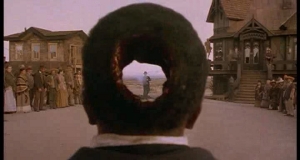
These are hollow archetypes, and Raimi purposefully hollows them out (“ventilates them,” you could say) until he has a cast he can focus on. Stone, Crowe (there’s a “stone the crows” joke there, somewhere) Hackman and DiCaprio are the square, surrounded by a circle of characters other people can just go and call “quirky” for all I care . I know a pack of comic book villains when I see them.
This is a comic book Western written by a Brit named Simon Moore, who so loved Spaghetti Westerns he toyed with the idea of directing one himself…before he sold the script to Sony. There, Sharon Stone dragged it through Production Hell by hitching her star to the project…along with Raimi’s. And Crowe’s. And DiCaprio’s.
Yeah, she had a lot of clout at the time. So much so that she insisted Raimi direct this thing, or she’d walk. She liked Army of Darkness. Always knew Sharon Stone and I had something in common. And these days, she and I can bask in our mutual hatred of the Saw franchise.
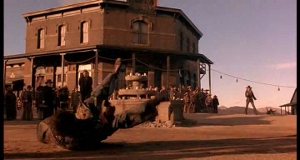
Too bad Basic Instinct ruined her career, huh? Play one super-powered, bisexual serial killer and everyone assumes that’s just who you are as an actor. That means you get positive reinforcement for playing into that set of assumptions. Why move yourself forward? Why bother to advance? Hence Stone’s habit of playing everything with such an absurd amount of sarcastic disaffection, emotion itself sounds inherently inauthentic coming out of her mouth.
It works here, because she’s playing a broad archetype, something actors love to do thanks to the role’s so-called “freedom.” Like American democracy, that freedom’s really an illusion, forcing the actors to the false choice between extremes: over or under playing? To be or not to be? This can lead to some real traps for actors like Stone and Crowe (who are all about body language and looking pretty – a role Westerns reserve for landscapes). But it makes for great performances by…well, the entire rest of the cast. Even Leonard DiCaprio.
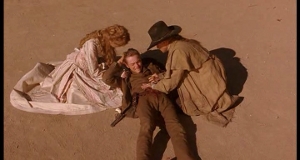
I hated Leo in 1995. You couldn’t be a pubescent boy and not hate the man for giving girls such unreasonable expectations of attractiveness. Then I find this movie, where Lex Luthor guns him down in the street. I thought I’d died and gone to Teenage Heaven. These days, I can see DiCaprio as Arnie Grape instead of Jack Dawson, and appreciate all the little mannerisms that so bored Gene Siskel at the time. (Dude, what the fuck kind of criticism is that? Would you watch a film full of Cybermen? I wouldn’t.)
Let me put it this way: I grew up on the twin Gospels of Bruce Wayne and the Original Series Star Trek. But by the end of the Gun Store Scene, where DiCaprio’s Kid lets out a two minute monologue of Gun Porn, even I wanted a .45 Schofield. “Me and Jessie James say it’s the best handgun in the world,” the Kid says. And I recognized it as the basis for Vash the Stampede’s trademark six-shooter. That automatically half-sold me, even before the Kid started his pitch.
And speaking of supervillains (and I was, seven paragraphs ago) I know Raimi probably hired Hackman to play King John Herod (slaughterer of the Woman With No Name’s innocence) because of Unforgiven, three years earlier, where he played basically the same character…but I’ll bet the gold teeth I don’t have that Hackman’s time in Superman factored into the decision. He brings more bombast to Raimi’s table than he brought to Eastwood’s, and he’s certainly more fun to watch. Because the script’s so purposefully light, he gets to do all he can, using the full force of his Acting. He can go from affable to playful to funny in the space of an expression. If we didn’t believe in him, if he weren’t such a rusty barrel of toxic humanity, leaking menace into every scene, then I’d agree with the general consensus and completely dismiss this film. But he’s here, and whether he’s berating the town for not appreciating him, or telling Our Heroine his villainous Origin Story, I love him and I love to hate him.
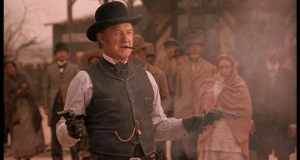
As it is, I don’t know how anyone could not love this flick. Sure, Russell Crowe can’t hold an American accent without mumbling, and Sharon Stone’s emotional range runs from snarling to screaming. But I don’t care. There’s plenty of stuff here to carry me through, apart from Raimi’s style. Big surprise, that counts for a lot with me. As with Darkman and Army, this is plainly the man who made Evil Dead playing with twice the money Spielberg had when he made Jaws. We get all the Raimi Montages, camera-as-fast-movie-object shots (bullets, obviously), push-pulls, deep-focus, and extreme closeups we could want. Siskel, Ebert and I agree on one thing: Lance Henriksen gets the best entrance in the movie, the camera panning across the kilometers of shadow he casts from the saloon door. That’s just awesome.
This brings something I’ve been meaning to talk about for awhile now. Movies don’t have to be perfect to be awesome, but in order to be good, they must be awesome enough to overcome their imperfections. Problems arise when critics attempt to define awesomeness. Artistic judgments are, by their very nature, subjective. No surprise the terms that make up those judgments tend to be subjective as well.
This film forms part of my personal definition of “awesome.” If you love Raimi’s movies, you probably already own it. It’s box office failure more or less put Raimi off movies until 1998…but don’t let that stop you. If you like Westerns, or reconstructivist Westerns from the 90s, give it a whirl. I can guarantee a good time, courtesy of Mr. Herod…and Wells Fargo.
![]()
![]()
![]()
![]()
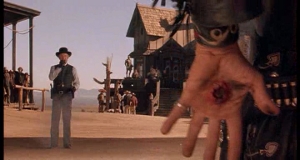

It’s a spaghetti Western turned up past 11, maybe to 12. If Leone shows a clock face, Raimi will snap-zoom to it as it’s hitting high noon with the loudest bell in the world pealing out from it. Hackman can’t kill Keith David without letting him know just how outmatched he is first. The blind bullet saleskid, the cigar store Indian who can’t be killed by a bullet, Leo DiCaprio learning a valuable lesson at the hands of his dad, it’s all in there. And Sharon Stone, looking good and shooting the joint up.
It’s Raimi having fun without a real sense that he needs to make a commercial movie, and God bless the man for that.
Damn right! And thank you, Steward. I was beginning to worry this one had completely dropped off the map.
Hell no, it didn’t go anywhere, it’s just that nobody seems to like it. “Oh Sharon Stone sucks and Leo wasn’t any good until the late 90’s” boo hoo this movie is better than almost any old school western as far as I’m concerned, Man With No Name movies and The Magnificent Seven excepted. As you touched on, most old westerns were boring. This movie didn’t have much plodding or padding, the plot structure just wouldn’t support it. The dialog is snappy and well written, the characters have depth where they need it but aren’t given too much time to yap on and on. If you tied a noose around my neck, put me up on a chair and threatened to shoot the legs from it out until I gave you my top 10 westerns, this one would definitely be on that list.
I’m glad you used the b-word before I had to. That’s why nobody beats the riz.
On the other hand, though, I’m gonna go back to lambasting Heaven’s Gate at every available opportunity. More people should see that film, if only to see what I consider to be the Platonic Ideal of a Boring Western, (complete with plenty of padding, and the almost-complete waste of its all-star cast).
Heh, you danced around it, but someone’s gotta call it like it is;) I of course understand why old westerns were the way they were, but that’s no excuse to make a movie like Heaven’s Gate in 1980.
A modern western, I think, is really a subgenre of the fantasy adventure film. As such, you really have to work on building at least some sense of wonder in the audience. That is a challenge, though. Too much wonder and you get something like Wild Wild West. Rami did a good job of building it using his characters; the oversized personalities and crazy ass skills of the gunslingers make them seem larger than life while fleshing them out just enough.
Thanks for the edit!
You mention that sense of wonder and I immediately flashed back to all those iconic, John Ford shots of monument valley…most of the best shot during a time before the U.S. Interstate Highway system made the national park vistas of the southwest accessible to a truly natural audience. We hear our world is shrinking, and I’ve always felt what people really mean by that is, “Things are easier to get to.” Including the vast, natural splendors that gave the Western its real spectacle. Admiring pretty people’s always nice (especially when they’ve been frozen in time by film) but you can find those in every movie. For me, the real wonder of most classical Westerns comes from an appreciation of their dramatic backdrops.
But, as time went on, those backdrops became familiar. Familiarity pushed out wonder. We needed Sergio Leone and all his imitators to come along and show us a new vista, a new “desert of the real.” I submit that, in this day and age, if a Western wants to engender the right kind of wonder, it needs one of two things, but should (pun most definitely intended) shoot for both: either a director capable of capturing the awful (in the sense that “it fills me with awe”) beauty of their setting (and Michael Cimino did that, no doubt…he just lingered on each shot for twenty minutes at a stretch), or characters interesting enough to engender awe by themselves (hence: Clint Eastwood). By having both, The Quick and the Dead wins my undying affection.
Raimi made a movie where he took everything non-essential out back and put it out of it’s misery. What’s left is The Quick and the Dead.
Indeed: and that seems the thing most chose to bitch about at the time. It’s kinda like Raimi managed to make the Anti-High Noon. Everyone loves that flick now, but at the time, it pissed people off mightily. “A Western without a bar fight or a band of Evil Indians? Gunfights that don’t even start until the damn thing’s almost over? Outrageous!” Here we have the Perpetual Gunfight. Set up ten minutes in, it begins before the movie’s a third over and literally becomes the film (which ends with the Quick Draw contest). There’s no accounting for taste.
Stone’s character is revenge/redemption for all the girls forced to play the Whore with the Heart of Gold or Calamity Jane in a musical or Pretty Polly on the railroad tracks, or the Spinster Schoolmarm – when we really knew we were the Man with No Name. Thanks for the reminder – can’t wait to watch it again. Just need to go to town for popcorn. I love westerns and this is one of the best.
And thank you for reminding me of Pretty Polly and the Spinster Schoolmarm. Now I have to go out and find representative samples of both.